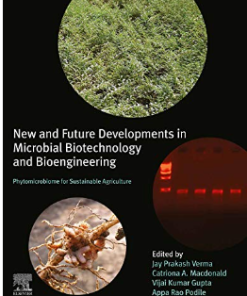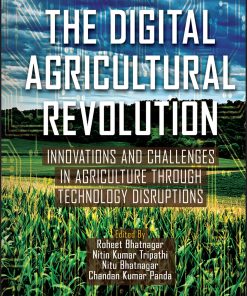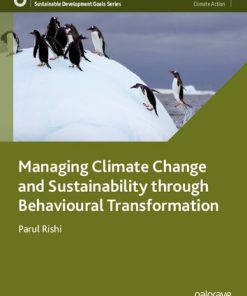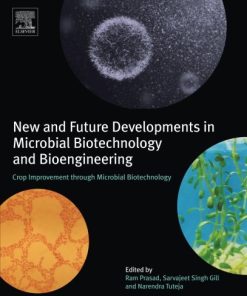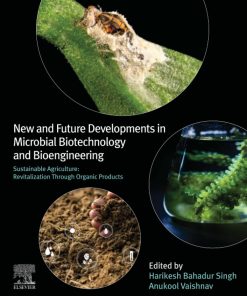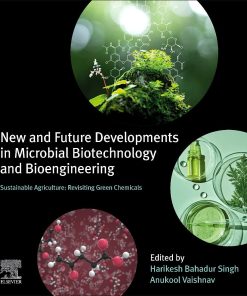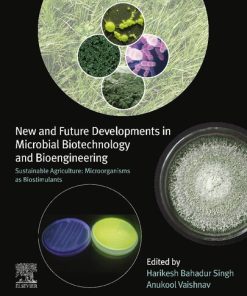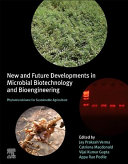(Ebook PDF) Plants genes and agriculture sustainability through biotechnology 1st edition by Maarten Chrispeels, Paul Gepts ISBN 9781605357188 1605357189 full chapters
$50.00 Original price was: $50.00.$25.00Current price is: $25.00.
(Ebook PDF) Plants genes and agriculture sustainability through biotechnology 1st edition by Maarten J. Chrispeels, Paul Gepts-Ebook PDF Instant Download/Delivery:9781605357188, 1605357189
Instant download Full Chapter of Plants genes and agriculture sustainability through biotechnology 1st edition after payment
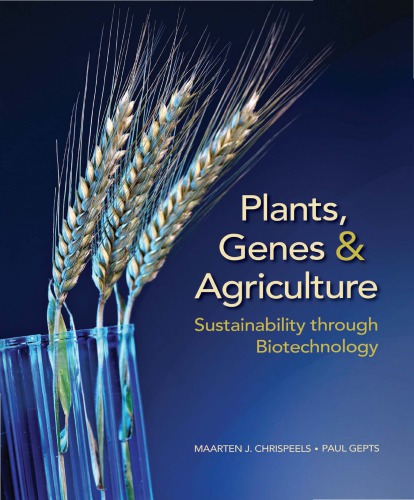
Product details:
ISBN 10: 1605357189
ISBN 13: 9781605357188
Author: Maarten J. Chrispeels, Paul Gepts
Table of Contents:
- Chapter 1 The Human Population and Its Food Supply in the 21st Century
- 1.1 Hunger and Malnutrition Persist in a World of Plenty
- 1.2 Human Population Growth Is Slowing
- 1.3 By How Much Does the Food Supply Need to Increase to Satisfy Future Demand?
- 1.4 Agriculture Must Become More Sustainable in the Future
- 1.5 An Uncertain Climate Presents Challenges to Food Production
- 1.6 Urbanization and Rising Living Standards Are Changing the Demand for Agricultural Products and t
- 1.7 Government Policies Play Pivotal Roles in Global Food Production
- 1.8 Agricultural Research Is Vital If We Are to Maintain a Secure Food Supply
- 1.9 Can Other Agricultural Methods and Policies Contribute to Feeding the Population?
- 1.10 Biotechnology Is Crucial for the Future of Food Production
- Chapter 2 A Changing Global Food System: One Hundred Centuries of Agriculture
- 2.1Hunting and Gathering Were the Methods of Food Procurement for Much of Human History
- 2.2 Agriculture Began in Several Places Some 10,000 Years Ago
- 2.3 Plants Are the Principal and Ultimate Source of All Our Food
- 2.4 Crop Production Today Takes Several Forms That Differ Dramatically in Productivity
- 2.5 Science-based Agricultural Practices Have Led to Significant Increases in Productivity
- 2.6 Farming and the Postharvest Food Delivery Pathway Combine to Provide Consumers with an Abundance
- 2.7 Agriculture and Food Production Are Significant Players in the Economic Systems of Developed Cou
- 2.8 Intensive Agriculture Has Environmental Effects That May Limit Its Long-term Sustainability
- Chapter 3 Plants in Human Nutrition, Diet, and Health
- 3.1 Animals Are Heterotrophs, Plants Are Autotrophs
- 3.2 Carbohydrates Are the Principal Source of Energy in the Human Diet
- 3.3 Fats Are a Source of Energy, Structural Components, and Essential Nutrients
- 3.4 Diets High in Energy Are Linked to Major Diseases
- 3.5 To Make Proteins, Animals Must Eat Proteins
- 3.6 Vitamins Are Small Molecules That Plants Can Make, but Humans and Other Animals Generally Cannot
- 3.7 Minerals and Water Are Essential for Life
- 3.8 Plants Produce Bioactive Molecules that Can Affect Human Health
- 3.9 The Consequences of Nutritional Deficiencies Can Be Severe and Long Lasting
- 3.10 Millions of Healthy Vegetarians and Vegans Are Living Proof that Animal Products Are Not a Nece
- 3.11 Are Organically Grown Plants and Products from Animals Fed with Organic Feed Worth the Addition
- 3.12 The Intestinal Microbiome Significantly Influences Health
- Chapter 4 Genes, Genomics, and Molecular Biology: The Basis of Modern Crop Improvement
- 4.1 Traits Are Inherited from One Generation to the Next
- 4.2 Genetic Information Is Replicated and Passed to New Cells during Cell Division
- 4.3 Genes Are Made of DNA
- 4.4 Gene Expression Involves RNA Synthesis Followed by Protein Synthesis
- 4.5 Gene Expression Is a Highly Regulated Process
- 4.6 Mutations Are Changes in Genes
- 4.7 Much of the Genome’s DNA Does Not Code for Proteins
- 4.8 DNA Can Be Manipulated in the Laboratory Using Tools from Nature
- 4.9 Creating GE Plants Depends on the Application of Naturally Occurring Horizontal Gene Transfer
- 4.10 Genome Sequencing and Bioinformatics Are Important Tools for Plant Biologists and Plant Breeder
- 4.11 Gene Editing Technologies Allow Us to Make Targeted Changes in an Organism’s DNA
- Chapter 5 Growth and Development: From Fertilized Egg Cell to Flowering Plant
- 5.1 The Plant Body Is Made Up of Cells, Tissues, and Organs
- 5.2 Development Is Characterized by Repetitive Organ Formation from Stem Cells
- 5.3 Gene Networks Interact with Hormonal and Environmental Signals to Regulate Development
- 5.4 In the First Stage of Development, Fertilized Egg Cells Develop into Embryos
- 5.5 Deposition of Food Reserves in Seeds Is an Important Aspect of Crop Yield
- 5.6 Maturation, Quiescence, and Dormancy Are Important Aspects of Seed Development
- 5.7 Formation of the Vegetative Body Is the Second Stage of Plant Development
- 5.8 Secondary Growth Produces New Vascular Tissues and Results in the Formation of Wood
- 5.9 Reproduction Involves the Formation of Flowers with Male and Female Organs
- 5.10 Fruits Help Plants Disperse Their Seeds
- 5.11 Developmental Mutants Are an Important Source of Variability to Create New Crop Varieties
- 5.12 Plant Cells are Totipotent: A Whole Plant Can Develop from a Single Cell
- Chapter 6 Converting Solar Energy into Crop Production
- 6.1 Photosynthetic Membranes Convert Light Energy to Chemical Energy
- 6.2 In Photosynthetic Carbon Metabolism, Chemical Energy Is Used to Convert CO2 to Carbohydrates
- 6.3 Sucrose and Other Polysaccharides Are Exported to Heterotrophic Plant Organs to Provide Energy f
- 6.4 Plants Gain CO2 at the Cost of Water Loss
- 6.5 Plants Make a Dynamic Trade-off of Photosynthetic Efficiency for Photoprotection
- 6.6 Abiotic Environmental Factors Can Limit Photosynthetic Efficiency and Crop Productivity
- 6.7 How Efficiently Can Photosynthesis Convert Solar Energy into Biomass?
- 6.8 Opportunities Exist for Improving the Efficiency of Photosynthesis
- 6.9 Global Climate Change Interacts with Global Photosynthesis
- Chapter 7 The Domestication of Our Food Crops
- 7.1 Wheat Was Domesticated in the Near East
- 7.2 Rice Was Domesticated in Asia and Western Africa
- 7.3 Maize and Beans Were Domesticated in the Americas
- 7.4 Domestication Is Accelerated Evolution Involving Relatively Few Genes
- 7.5 Crop Evolution Was Marked by Genetic Bottlenecks That Decreased Diversity
- 7.6 Hybridization Plays a Role in the Appearance of New Crops, the Modification of Existing Crops, a
- 7.7 Polyploidy Led to New Crops and New Traits
- 7.8 Sequencing Crop Plant Genomes Provides Insights into Plant Evolution
- Chapter 8 From Classical Plant Breeding to Molecular Crop Improvement
- 8.1 Plant Breeders Have a Long Wish List
- 8.2 Plant Breeding Involves Introduction of Genetic Diversity, Hybridization, and Selection of New G
- 8.3 Genetic Variation Manipulated by Selection Is the Key to Plant Breeding
- 8.4 The Breeding Method Chosen Depends on the Pollination System of the Crop
- 8.5 F1 Hybrids Yield Bumper Crops
- 8.6 Backcrossing Comes as Close as Possible to Manipulating Single Genes via Sexual Reproduction
- 8.7 Quantitative Traits Are More Complex to Manipulate Than Qualitative Traits
- 8.8 The Green Revolution Used Classical Plant Breeding Methods to Increase Wheat and Rice Yields
- 8.9 Tissue and Cell Culture Techniques Facilitate Plant Breeding
- 8.10 The Technologies of Gene Cloning and Plant Transformation Are Key Tools to Create GE Crops
- 8.11 Marker-assisted Breeding Helps Transfer Major Genes
- 8.12 Genome Sequencing Has Become an Essential Tool of Plant Breeding Programs
- 8.13 High-Throughput Trait Measurement Facilitates Phenotyping for Crop Breeding
- Chapter 9 Plant Propagation by Seeds and Vegetative Processes
- 9.1 Commercial Seed Production Is Often Distinct from Crop Production
- 9.2 Seed Certification Programs Guarantee and Preserve Seed Quality
- 9.3 Saving Seeds Securely Is an Important Aspect of Agriculture in Developing Countries
- 9.4 Seed Germination, Seedling Establishment, and Seed Treatments Are Important Agronomic Variables
- 9.5 Enhancing Microbial Biofertilizers in the Soil Is an Important Technology for Crop Production
- 9.6 Seed Banks Preserve Genetic Diversity for the Future
- 9.7 Sterile Tissue Culture Is Used for Micropropagation and the Production of Somatic Embryos
- 9.8 Grafting Is Widely Used in the Fruit Industry to Propagate Superior Varieties
- 9.9 Apomixis Is a Unique Way in which Some Plant Species Reproduce
- Chapter 10 Innovations in Agriculture: How Farm Technologies Are Developed and How They Reach Farmer
- 10.1 Biological and Technological Innovations Have Improved Farming Practices since the Early Days o
- 10.2 Innovations in Agriculture Require Substantial Research in Many Fields
- 10.3 Patents Stimulate Invention and Improvements
- 10.4 Farmers Obtain Seeds in Different Ways
- 10.5 Minor Crops and New Production Methods Are Important
- 10.6 Agricultural Technologies and Practices Are Subject to Oversight and Regulation
- Chapter 11 Soil Ecosystems, Plant Nutrition, and Nutrient Cycling
- 11.1 Soil Ecosystems Are Fundamental to Agriculture
- 11.2 Particles Created by Weathering Are the Medium of Soil Ecosystems
- 11.3 Living Organisms and Their Remains Are Important Components of Soil Ecosystems
- 11.4 Plants Need Six Mineral Elements in Large Amounts and Eight Others in Small Amounts
- 11.5 Productivity May Be Limited by the Availability of Soil Water and Nutrients
- 11.6 Soil Organic Matter Is a Key Determinant of Soil Fertility
- 11.7 Roots Are the Foundation of Soil Food Webs and Soil Adhesion
- 11.8 Phosphorus Is the Rock-derived Nutrient That Most Commonly Limits Crop Productivity
- 11.9 Nitrogen-fixing Bacteria and Industrial Nitrogen Fixation Drive the Nitrogen Cycle
- 11.10 Mycorrhizae Are Plant–Fungi Mutualisms That Help Plants Acquire Nutrients
- Chapter 12 Biotic Challenges: Weeds
- 12.1 Weeds Are Plants Adapted to Environments Disturbed by Humans
- 12.2 Weeds Interfere with Crop Plant Growth
- 12.3 Weed Control Is Achieved by Cultural, Mechanical, Biological, and Chemical Practices
- 12.4 Herbicides Kill Plants by Interfering with Vital Plant-specific Processes
- 12.5 First Chemistry and then Biotechnology Transformed Weed Control
- 12.6 Weeds Adapt to Our Attempts To Control Them
- 12.7 Herbicide Resistance and a Lack of New Herbicides Are Challenges to Weed Control
- 12.8 New Methods of Weed Control Are Emerging
- Chapter 13 Plant Diseases and Strategies for Their Control
- 13.1 Microbial Infections Diminish Crop Yields, but Plants Fight Back
- 13.2 Disease Epidemics Occur When Multiple Factors Converge
- 13.3 Viruses and Viroids Have Only a Few Genes
- 13.4 Cellular Pathogens Use Effector Proteins That Act in the Host Plant
- 13.5 Plant-pathogenic Bacteria Cause Many Economically Important Diseases
- 13.6 Pathogenic Fungi and Oomycetes Collectively Cause the Greatest Crop Losses
- 13.7 Chemical Strategies for Disease Control Can Be Effective but Problematic
- 13.8 Plants Mount Defenses to Ward Off Pathogens; Successful Pathogens Elude the Defenses
- 13.9 Resistance to Pathogens Can Be Introduced into Plants by Breeding and Genetic Engineering
- 13.10 The Plant Immune System Can Be Activated So Subsequent Infections Are Met with a Stronger Resp
- Chapter 14 Biotic Challenges: Pests
- 14.1 Arthropod Pests Cause Substantial Crop Losses
- 14.2 Parasitic Nematodes Cause Substantial Crop Losses
- 14.3 Plants Have Chemical Defenses against Pests
- 14.4 Improved Cultural Practices Can Help Control Pests
- 14.5 Integrated Pest Management Can Control Outbreaks
- 14.6 Plant Breeding Methods Accelerate the Development of Pest-resistant Crop Varieties
- 14.7 Properly Applied, Synthetic Chemicals Can Provide Effective Pest Control
- 14.8 Genetically Engineered Plants Provide New Opportunities
- 14.9 Evolution Keeps Chemists, Plant Breeders, and Molecular Biologists Busy
- Chapter 15 Abiotic Stresses and How They Affect Crop Yield
- 15.1 Plants Sense Abiotic Stresses and Respond to Them
- 15.2 Plant Growth Depends on an Active Transpiration Stream
- 15.3 The Molecular Responses to Water Deficit Involve Signals from the Root
- 15.4 Too Much Water Depletes Oxygen in the Roots and Leads to Cell Death
- 15.5 Crops Experience Osmotic Stress and Sodium Toxicity
- 15.6 Plants Sequester Toxic Ions in Vacuoles
- 15.7 Heat Stress During Reproductive Growth Severely Diminishes Crop Yield
- 15.8 Many Crop Plants That Originated in Tropical Regions Are Sensitive to Cold
- 15.9 The Crops That Feed Humanity Are Not Well Adapted to Alkaline or Acidic Soils
- 15.10 Agricultural Practices and Global Climate Change May Exacerbate Abiotic Stresses
- Chapter 16 Introduced Traits That Benefit Farmers and Industry
- 16.1 Crops Bred Using Genetic Engineering Approaches Were Introduced in the Mid 1990s
- 16.2 Herbicide-tolerant GE Crops Facilitate Weed Management
- 16.3 Genetic Engineering of Insect Resistance Decreases Pesticide Use on Several Major Crops
- 16.4 Alleviating Water-deficit Stress Is an Increasingly Important Goal of Crop Improvement
- 16.5 Common Bean Provides an Example of Protecting against Virus
- 16.6 Uptake and Assimilation of Nitrogen Can Be Enhanced by Genetic Transformation
- 16.7 Phosphate Uptake Can Be Improved by Transgenic and Traditional Approaches
- 16.8 Pod Shatter-resistant Canola Prevents Seed Losses and Increases Yield
- 16.9 Genetically Engineered Forest Trees Are a New Frontier in Biotechnology
- 16.10 Male-sterile Lines and Fertility-restorer Genes Facilitate Hybrid Seed Production
- Chapter 17 Introduced Traits That Benefit the Consumer
- 17.1 Enhancing Essential Nutrients or Eliminating Harmful Ones Creates Functional Foods
- 17.2 Golden Rice Is the Poster Child for Genetic Engineering in the Service of Humanity
- 17.3 Biofortifying Crops with Iron Is a Major Goal of Nutritionists
- 17.4 Heat-stable Vegetable Oils Are Better Suited for Deep-frying
- 17.5 Biotechnology Can Help Eliminate Food Allergens, but These Innovations May Not Come to Market
- 17.6 Acrylamide Can Be Eliminated from Processed Foods
- 17.7 Genetic Engineering Can Help Reduce Postharvest Food Losses
- 17.8 Conquering Citrus Greening Disease Could Lower the Price of Orange Juice
- 17.9 Are Tastier Tomatoes in Our Future?
- Chapter 18 Food Safety: Are Foods Made from GE Crops Safe to Eat?
- 18.1 Humans Have Continuously Been Exposed to Novel Foods
- 18.2 The Safety of Genetically Engineered Food Crops Has Been Extensively Debated
- 18.3 Genetically Engineered Food and Feed Crops Have an Excellent Safety Record
- 18.4 Specific Principles of Food Safety Assurance Apply to Foods and Feeds Developed Using Biotechno
- 18.5 Evaluation of Variability Is a Major Tool to Limit Unintended Changes in GE Crops
- 18.6 Molecular Characterization of Intended Changes and Added Proteins Is a Necessary Component of S
- 18.7 Chemical Risk Evaluation Involves Investigating the Relationship between Degree of Exposure and
- 18.8 Food Safety Experiments Demand High Standards of Experimental Design and Interpretation
- 18.9 Perspectives on the Impacts of Crop Biotechnology on Human and Animal Health Are Changing
- Chapter 19 Challenges and Solutions for Subsistence Farmers
- 19.1 Subsistence Farmers Grow a Diversity of Crops to Maintain Resiliency
- 19.2 Intensifying Agricultural Output on Smallholds Must Be a Priority
- 19.3 Water Is a Challenge for Smallhold Farmers
- 19.4 Degraded Soils and Soil Erosion Are Life-threatening Issues for Smallholders
- 19.5 Weed Control Is a Major Burden on Women and Girls in Developing Countries
- 19.6 Indigenous Farmers Have Strategies to Combat Pests and Diseases
- 19.7 There Are Hazards and Drudgery in Harvest and Postharvest Work
- 19.8 Maximizing Profit after Harvest Is Critical
- 19.9 The Public–Private Sector Job Creation Model Can Apply to Smallholders
- Chapter 20 Plants as Chemical Factories
- 20.1 Plant Secondary Metabolism Is a Treasure Chest of High-value Chemicals
- 20.2 Several Different Platforms Are Used to Produce Plant Secondary Metabolites for Human Use
- 20.3 Plant Cells Cultured in Bioreactors Constitute Sustainable “Green Factories”
- 20.4 Metabolic Engineering of Plants Results In Higher Yields and Superior Quality Chemicals
- 20.5 Transferring Metabolic Pathways into Microorganisms Is a Promising Approach to Producing Second
- 20.6 Microalgae Are Potentially Renewable Resources for a Bio-based Society
- 20.7 The World Needs Biodegradable Plastics
- Chapter 21 Plants as Factories for the Production of Protein Biologics
- 21.1 Plants Can Be Used as Factories for Protein Biologics
- 21.2 There Are Several Production Strategies for Making Protein Biologics in Plants
- 21.3 Agroinfiltration Is an Effective Way of Delivering Transgenes into Plants
- 21.4 New Vectors for Gene Delivery Are Being Developed
- 21.5 The Plant Host and Plant Organs Used to Produce Biologics Must Be Chosen Carefully
- 21.6 Monoclonal Antibodies and Vaccine Candidates Can Be Produced in Plants
- 21.7 A Plant-manufactured Biologic Has Been Approved to Treat a Genetic Disease in Humans
- Chapter 22 Sustainable Food Production in the 21st Century
- 22.1 Agricultural Intensification and Sustainability Are Equally Important
- 22.2 Can We Decrease the Yield Gap?
- 22.3 Smarter Agronomy Can Deliver Higher Yields
- 22.4 Wider Acceptance of GE Technology Is Essential if We Are to Increase Food Supplies
- 22.5 Research Is Key to Increasing the Intensity of Crop Production
- 22.6 Education at All Levels Is Essential if We Are to Increase Food Production
- 22.7 Maintaining the Resource Base Is Essential for Food Production
- 22.8 We Must Diminish Agriculture’s Contribution to Climate Change and Global Pollution
- 22.9 Sustainability Will Require Greater Attention to Food Waste
People also search:
plants genes and agriculture
plant genes genomes and genetics
plant genetics textbook
plants genes
plant genes examples
Tags:
Maarten Chrispeels,Paul Gepts,Plants,Genes,Agriculture,Sustainability,Biotechnology
You may also like…
Biology and other natural sciences - Microbiology
Biology and other natural sciences - Plants: Agriculture and Forestry
Uncategorized
Managing Climate Change and Sustainability through Behavioural Transformation Parul Rishi
Science (General)
Engineering - Bioengineering
Biology and other natural sciences - Biotechnology
Uncategorized
Biology and other natural sciences - Biotechnology
Biology and other natural sciences - Microbiology




